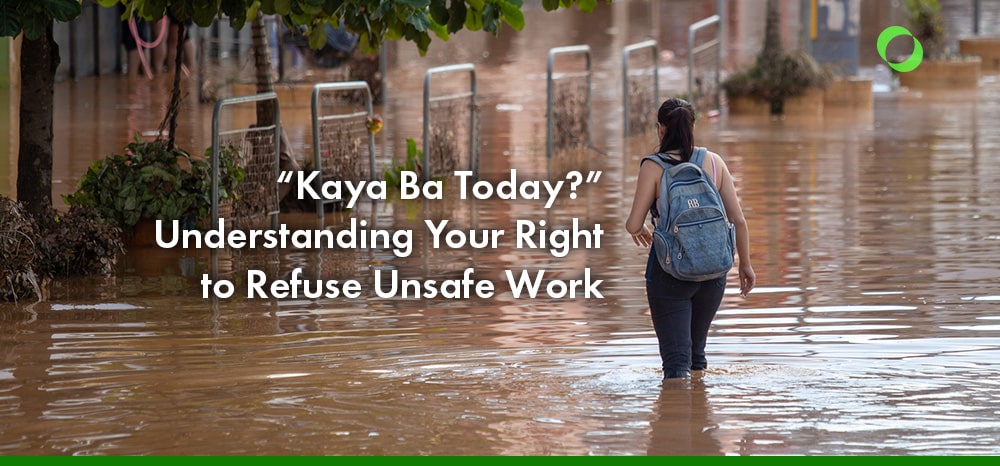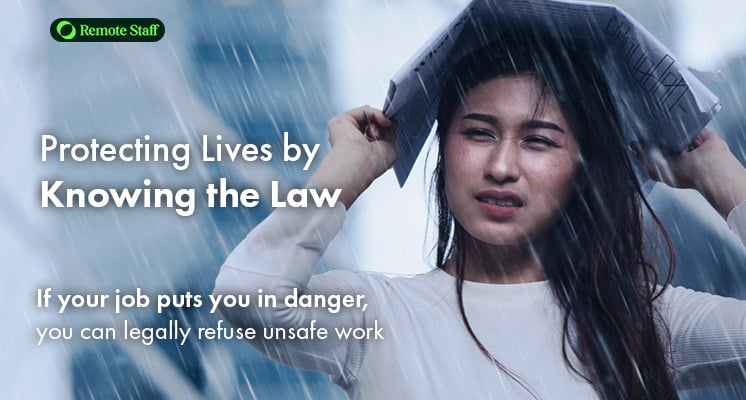With the recent heavy rains and flooding across Metro Manila and nearby provinces, many workers faced unsafe conditions just trying to get to work.
It begs the question: can you say no to unsafe work without risking your job?
Yes, you can, if there’s real danger involved.
However, there’s a proper way to go about it. Let’s dive in.
Safety Is a Right, Not a Privilege
Every Filipino worker has the right to a safe workplace. It’s even mandated by the law.
Under the Occupational Safety and Health Standards (OSHS) Law or Republic Act No. 11058, you have the legal right to refuse unsafe work.
This is further supported by Article 128 of the Philippine Labor Code, which gives the Department of Labor and Employment (DOLE) the power to inspect workplaces, enforce safety standards, and even stop work if they deem the conditions dangerous.
How Your Rights to Safety Figure in a Disaster‑Prone Country
The Philippines is regularly battered by monsoons, typhoons, and sudden flooding—natural events that can quickly turn everyday travel and work routines into life-threatening situations.
This legal protection ensures that no employee should be forced to work in unsafe working conditions that could cause serious harm or even death.
Knowing your rights can help you make safer decisions when disaster strikes, whether you’re in the workplace or on your way there.
How Do Local Governments Declare Class and Work Suspensions?
In July 2025, several days of heavy rain from the southwest monsoon caused widespread flooding.
On July 23, the government suspended both classes and government work in Metro Manila and 29 provinces due to dangerous conditions.
The Department of the Interior and Local Government (DILG) confirmed that local government units (LGUs) have the authority to declare localized suspensions, not just for schools, but for government offices as well, especially when PAGASA issues red or orange rainfall warnings or flood alerts.
While private companies aren’t always required to follow LGU declarations, many abide to protect their workers’ safety – and to avoid liabilities.
Spot.ph explains that these LGU announcements carry legal weight and are based on public safety alerts, not just personal judgment.
So if your LGU suspends work due to flooding or severe weather, and your immediate supervisor still requires you to come in for work, you CAN refuse – without fear of any legal reprisals.
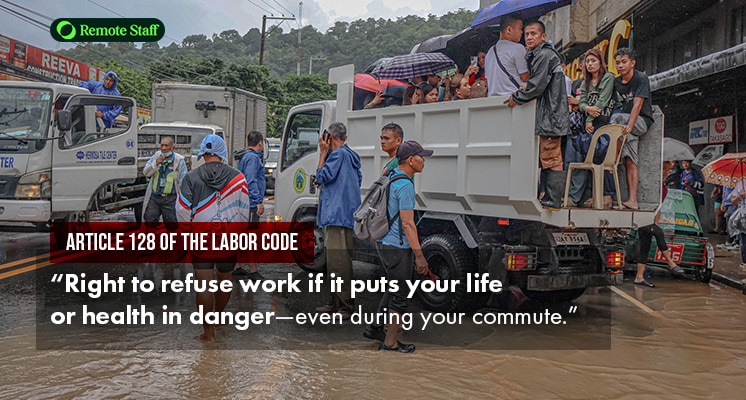
What the Law Says About Refusing Unsafe Work
Not all workers know this, but the law is on your side when it comes to workplace safety.
Under the OSHS Law, Labor Code, and DOLE guidelines, you have the legal right to refuse work if it puts your life or health in danger—even during your commute.
Department of Labor and Employment Guidelines
The DOLE enforces workplace safety through inspections, regulations, and emergency work stoppage orders.
Under Article 128 of the Labor Code, DOLE has the authority to inspect establishments and suspend operations if conditions pose serious risks to workers.
This applies not just to what happens inside the workplace, but also during extreme weather where the commute itself becomes hazardous.
DOLE encourages employers to prioritize worker safety and consider flexible arrangements when disaster alerts are in effect.
Provisions Under the Occupational Safety and Health Standards (OSHS)
According to OSHS, workers have the right to refuse unsafe work.
This is part of OSHS worker rights, which protect employees from harmful conditions.
Under Section 6 of the law’s Implementing Rules, a worker may refuse to work without fear of retaliation if:
- There is an imminent danger to life or health (e.g., floodwaters, landslides, power lines down during commute);
- The employer does not or cannot correct the danger immediately;
- The worker has notified the employer of the risk.
Imminent danger at the workplace doesn’t only refer to broken machines, insufficient protective gear, or exposed wires—it can also pertain to unsafe travel during floods, typhoons, or other emergencies.
So if your commute puts your life at risk and your employer can’t mitigate the danger or provide a safe alternative (such as remote work or transport), you have legal grounds to refuse to work under such conditions.
Types of Unsafe Work Conditions Covered by the Law
Unsafe conditions include, but aren’t limited to:
- Natural Disasters (Flooding, Earthquakes, Typhoons): Dangerous commutes, flooded streets, or structurally unsound buildings after severe weather.
- Unsafe Machinery or Work Environments: Malfunctioning equipment, poor ventilation, fire hazards, or structural risks inside the workplace.
- Exposure to Harmful Substances or Violence in the Workplace: Handling toxic chemicals without protection, unsanitary conditions, or unaddressed harassment or threats.
- Lack of Proper PPE or Safety Training: Being asked to perform hazardous tasks without the necessary protective gear or proper training.
If local authorities suspend work due to PAGASA alerts but your employer still asks you to report in unsafe conditions, you have the right to refuse, especially if the danger can’t be avoided or reduced.
How to Refuse Unsafe Work Without Legal Risk
Refusing unsafe work doesn’t mean walking off the job without warning. The law protects you, but only if you follow proper procedures.
Procedures for Refusal According to DOLE
The Department of Labor and Employment (DOLE) outlines clear hazard reporting procedures when refusing unsafe work:
- Assess the situation – Determine if there’s a real and immediate threat to your health or safety.
- Notify your supervisor or employer – Clearly explain the danger and your concerns.
- Wait for the employer to act – Give your employer a chance to fix or remove the danger.
- Refuse to work if the risk remains – If the danger isn’t resolved and still poses a threat, you have the right to refuse work.
This process is known as a good faith work refusal, meaning the decision is made sincerely, based on legitimate safety concerns—not as an excuse to skip work.
DOLE recommends keeping communication respectful and focused on safety.
Documentation and Reporting Requirements
To protect yourself legally, keep a record of:
- The time and date you reported the danger
- Who you informed
- A description of the unsafe condition
- Any photos or videos (if applicable)
- Copies of relevant alerts (e.g., PAGASA warnings, LGU announcements)
You can also file a report with DOLE for formal documentation. Thorough unsafe work documentation strengthens your case in case of disputes or retaliation.
What to Do if Your Employer Retaliates
It’s illegal for employers to punish workers for refusing unsafe work.
If you’re demoted, suspended, fired, or harassed after raising a safety concern:
- File a complaint with DOLE immediately
- Gather all communication and evidence related to the incident
- Seek legal advice or assistance through DOLE’s help desks or a labor lawyer
Under Republic Act No. 11058, employer retaliation protection is guaranteed.
Employers who retaliate against workers for asserting their safety rights can face penalties.
DOLE Actions Supporting Workers’ Right to Refuse Unsafe Work
The right to refuse unsafe work is protected by law—and DOLE has backed workers in real situations. Here are some examples:
Stephen Corilla / URC Case
At Universal Robina Corporation (URC), a worker named Stephen Corilla died in a machine-related accident. The company didn’t report it right away or stop work after the incident.
DOLE said the company failed to protect its workers. It reminded employers that:
- Workers can refuse unsafe work.
- Work must stop immediately in dangerous situations.
- Wages should still be paid during the work stoppage.
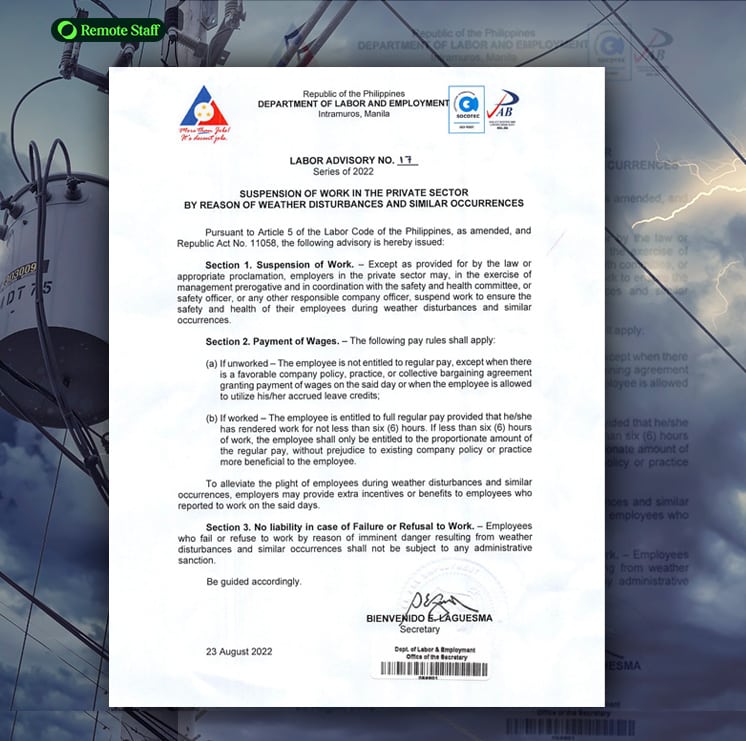
Weather Disturbance Advisory
Under Labor Advisory No. 16 (2022), DOLE said workers can say no to work during typhoons or severe weather—and they can’t be punished for it.
Employers must:
- Respect workers’ choice to stay safe during bad weather.
- Avoid giving penalties for missing work on stormy days.
- Adjust schedules or give remote options when needed.
General Unsafe Working Conditions
DOLE and the National Labor Relations Commission (NLRC) have also handled various complaints about unsafe factory environments.
In some factories, workers filed complaints about unsafe setups—like no ventilation or broken equipment.
DOLE and the NLRC took action by:
- Ordering safety improvements.
- Fining companies that ignored the rules.
- Reinstating fired workers.
- Filing legal charges in serious cases.
These are legal precedents that demonstrate how Philippine labor agencies enforce the right to a safe workplace.
You can learn more about the complaint process and relevant laws in this detailed guide.
Misconceptions About the Right to Refuse Work
Many workers are unsure about how and when they can say no to unsafe work. Some are even afraid to speak up because of widespread myths.
Let’s clear up a few of them so you know how to protect yourself:
“Only Factory or Construction Workers Can Refuse Unsafe Work”
Many think only those in high-risk jobs like construction or manufacturing can refuse unsafe work.
In reality, any worker—whether in an office, retail, or service role—can exercise this right if getting to or staying at work poses a real danger to their safety or health.
“A Refusal Isn’t Valid Without a DOLE Inspector On-Site”
You don’t need to wait for a government inspector to show up before taking action.
If there’s an immediate risk, you have the right to refuse work as long as you follow proper procedures like reporting the hazard and documenting it.
“Refusing Dangerous Work Means Losing Your Job”
Some workers fear losing their jobs for speaking up. However, under the law, overt employer retaliation is illegal.
As long as you refuse work in good faith and follow guidelines in the previous section, your job should be safe.
The Role of Employers in Upholding the Right to a Safe Workplace
Workplace safety isn’t just a worker’s concern—it’s a shared responsibility.
Employers must follow workplace safety laws and play an active role in keeping their staff protected, informed, and empowered to act when faced with unsafe conditions:
Updating Company Safety Protocols and Guidelines
Companies should regularly review their safety procedures to stay aligned with government alerts and actual workplace conditions. Following updated health and safety regulations means:
- Setting clear rules on when to suspend work based on weather warnings
- Considering commuting hazards, not just on-site risks
- Preparing backup plans like remote work, emergency updates, or transport assistance
These precautionary steps help avoid confusion and keep everyone safe during emergencies.
Educating Teams About Labor Rights and Safety Protocols
Many workers are unaware of their legal protections, including their right to dangerous job refusal.
Helping employees understand these rights and your company’s safety policies prevents confusion and legal issues before they arise.
If your team knows what to do during an emergency—like shifting to remote work or reporting unsafe locations—they’re more likely to stay calm and act responsibly.
You don’t need to wait for an emergency. Anticipate contingencies by setting clear policies on:
- When to enable remote work due to weather or safety risks
- Who to report to if a location becomes unsafe
- What steps to follow if someone feels at risk during their commute or while on fieldwork
- Why it’s important to stay on site during refusal:
If employees were already at work when the emergency occurred, it’s important to stay on site during refusal of unsafe work while waiting for the issue to be addressed.
Leaving without following the proper steps could jeopardize the extent of legal protection or be seen as job abandonment.
These measures won’t just protect your team—they also protect your operations, reduce disruptions, and show that your company takes its responsibility towards employee safety seriously.
Encouraging Dialogue Between Workers and Management — When Employers Can Challenge a Refusal (and When They Shouldn’t)
Open communication between workers and employers helps prevent misunderstandings and supports a safer workplace.
It also plays a key role in strengthening collective bargaining and safety, especially when concerns are raised through unions or worker councils, prompting companies to take proactive steps.
In this context, it’s important to understand when employers can respond to a refusal to work—and when they shouldn’t:
When employers can respond to a refusal: If the danger can be reduced (like offering transport or work-from-home options), they can suggest safer alternatives.
When they shouldn’t: If there’s a serious risk—like heavy flooding or unsafe buildings—workers have every right to say no, and that choice should be respected.
The goal is to keep everyone safe, not just to meet deadlines.
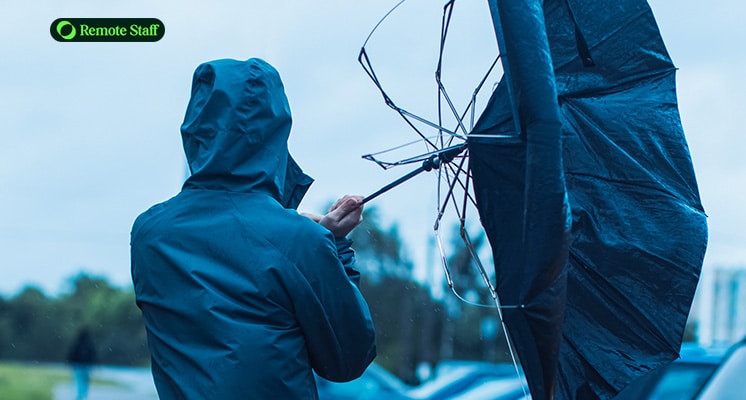
Understanding the Boundaries of The Right to Refuse Work
The right to refuse unsafe work is protected by law—but it must be used responsibly.
Some common reasons given include:
- Slow or no internet
- Power outages
- Flooding or bad weather
- Transportation disruptions (e.g., no safe routes to work due to road closures)
Now, these reasons are all valid. However, if they’re exaggerated or used too often without proof, they can affect work and damage trust between employees and management.
Some instances that are often misused include:
- Feeling sick (like headaches or dizziness) without a medical certificate
- Suspiciously frequent family emergencies without documentation
- Unfounded rumors or hearsay about danger that aren’t confirmed by official sources
This applies to both remote and on-site employees.
Employers have the right to verify these claims—not to punish employees, but to ensure that work refusal is based on real risks. They may ask for reasonable proof such as:
- Medical certificates
- Photos or videos of flooded areas or power outages
- Official weather or safety advisories
- Barangay or LGU reports
This helps keep the process fair and balanced. It ensures that the right to refuse unsafe work is used responsibly and not at the expense of team productivity or trust.
Remember: Work refusal must be based on actual danger—not just inconvenience.
Clear communication and proper documentation are key.
Frequently Asked Questions (FAQs)
Still unsure how the right to refuse unsafe work applies to your situation? Here are answers to common questions:
Can I still get paid if I refuse unsafe work?
Yes, but it depends on the situation:
- If there’s an official work stoppage (from DOLE or your LGU) due to weather or a catastrophe, and you don’t report to work, you may still be entitled to pay, especially if your employer has a policy saying so or if you worked partial hours.
- If unsafe conditions are caused by your employer’s negligence, and an official stoppage is issued, you must still be paid under Section 23 of RA 11058.
- If you refuse to work on your own in good faith, your job is protected—but your employer isn’t legally obligated to pay you unless an official stoppage is declared or unless your employment contract has provisions for such.
What happens if the unsafe condition was a false alarm?
If you acted in good faith and truly believed there was serious danger, you are still protected, even if the risk wasn’t as bad as expected.
Can contractual or agency workers exercise this right?
Yes. Worker safety rights apply to all employees—whether they’re regular, contractual, or outsourced via an agency.
Everyone has the legal right to refuse unsafe work under the Occupational Safety and Health Standards.
How can I prove my work environment was unsafe?
Keep documentation like photos, videos, weather alerts, LGU announcements, and messages to or from your employer. These can support your claim if needed.
What government office should I contact for help?
You can report issues to the Department of Labor and Employment (DOLE) or seek assistance from their regional offices or help desks.
Conclusion: Protecting Lives by Knowing the Law
Every worker has the right to a safe workplace. If your job puts you in danger (especially during disasters), you can legally refuse unsafe work if you follow the proper steps.
If you notice unsafe conditions, speak up, follow the proper steps, and do your part in helping your company create a safer workplace for everyone.
Looking for a safer and more flexible setup that won’t require you to venture our in inclement weather? Remote Staff offers online jobs that let you work from home. We also have virtual assistant jobs and other remote opportunities you can explore.
Register with Remote Staff today and enjoy the safety and convenience of working from home.

